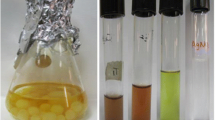Abstract
Nanoparticles are usually 1–100 nm in each spatial dimension considered as building blocks of the next generation of optoelectronics, electronics, and various chemical and biochemical sensors. In the synthesis of nanoparticles use of microorganisms emerges as an eco-friendly and exciting approach that reduce waste products (ultimately leading to atomically precise molecular manufacturing with zero waste); the use of nanomaterials as catalysts for greater efficiency in current manufacturing processes by minimizing or eliminating the use of toxic materials (green chemistry principles); the use of nanomaterials and nanodevices to reduce pollution (e.g. water and air filters); and the use of nanomaterials for more efficient alternative energy production (e.g. solar and fuel cells). Fungi have many advantages for nanoparticle synthesis compared with other organisms. In this study, Geotricum sp. found to successfully produce Ag nanoparticles. Geotricum sp. was grown in SDA (Sabro Dextrose Agar) medium at 25 ± 1 °C for 96 h. The mycelia were used to convert silver nitrate solution into nano-silver. Silver nanoparticles were synthesized using these fungi (Geotricum sp.) extracellularly. UV–VIS spectroscopy, Atomic Force Microscopy (AFM) and Scanning Electron Microscopy images shows the nanoparticle formation in the medium. Energy-dispersive X-ray spectroscopy (EDX) also confirmed that silver nanoparticles in the range of 30–50 nm were synthesized extracellularly. FTIR analyses confirmed the presence of amide (I) and (II) bands of protein as capping and stabilizing agent on the surface of nanoparticles.





Similar content being viewed by others
References
T. Riddina, M. Gerickeb, and C. G. Whiteleya (2010). EMT J. 46, 501–505.
N. Pugazhenthiran and S. Anandan (2009). J. Nanopart. Res. 11, 1811–1815.
M. Rai and A. Yadav, in Applied Mycology (CAB International, New York, 2009).
P. Mukherjee and A. Ahmad (2001). Nano Lett. 1, (10), 515–519.
S. Murali (2003). Curr. Sci. 85, 2.
M. Karbasian, S. M. Atyabi, and S. D. Siadat (2008). Am. J. Agric. Biol. Sci. 3, (1), 433–437.
K. B. Narayanan and N. Sakthivel (2010). Adv. Colloid Interface Sci. 156, 1–13.
P. Mohanpuria and N. K. Rana (2008). J. Nanopart. Res. 10, 507–517.
N. Saifuddin, C. W. Wong and A. A. Nur (2009). EJ. Chem. 6(1), 61–70.
N. Durán, P. D. Marcato, and O. L. Alves (2005). J. Nanobiotechnol. 3, 8.
D. Mandal, M. E. Bolander, and D. Mukhopadhyay (2006). Appl. Microbiol. Biotechnol. 69, 485–492.
L. Sintubin and W. De Windt (2009). Appl. Microbiol. Biotechnol. 84, 741–749.
K. C. Bhainsa and S. F. D’Souza (2006). Colloids Surf. Biointerfaces 47, 160–164.
R. Varshney, A. N. Mishra, S. Bhadauria, and M. S. Gaur (2009). Dig. J. Nanomater. Biostruct. 4, (2), 349–355.
A. Nanda and M. Saravanan (2009). Nanomed. Nanotechnol. Biol. Med. 5, 452–456.
K. N. Thakkar, S. S. Mhatre, and R. Y. Parikh (2010). Nanomed. Nanotechnol. Biol. Med. 6, (2), 257–262.
A. K. Jha and K. Prasad (2010). Biotechnol. J. 5, (3), 285–291.
Balaji Dasaratrao Sawle et al (2008). Sci. Technol. Adv. Mater. 9, 035012.
A. Ahmad, P. Mukherjee, S. Senapati, D. Mandal, M. I. Khan, R. Kumar, and M. Sastry (2003). Extracellular biosynthesis of silver nanoparticles using the fungus Fusarium semitectum. Colloids Surf. B 28, 313–318.
K. Kalishwaralala, V. Deepaka, and S. B. Ram Kumar Pandian (2010). Colloids Surf. B Biointerfaces 77, 257–262.
Author information
Authors and Affiliations
Corresponding author
Rights and permissions
About this article
Cite this article
Jebali, A., Ramezani, F. & Kazemi, B. Biosynthesis of Silver Nanoparticles by Geotricum sp.. J Clust Sci 22, 225–232 (2011). https://doi.org/10.1007/s10876-011-0375-5
Received:
Published:
Issue Date:
DOI: https://doi.org/10.1007/s10876-011-0375-5




